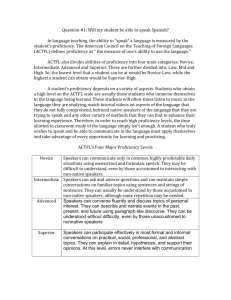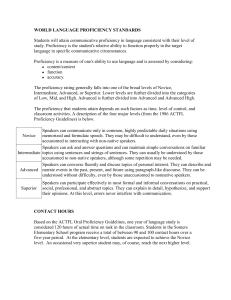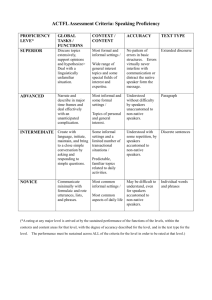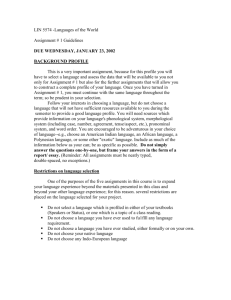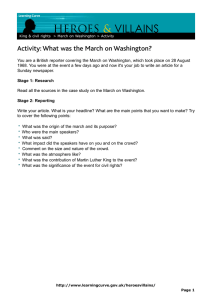ACTFL PROFICIENCY GUIDELINES SPEAKING American Council on the Teaching of Foreign Languages
advertisement
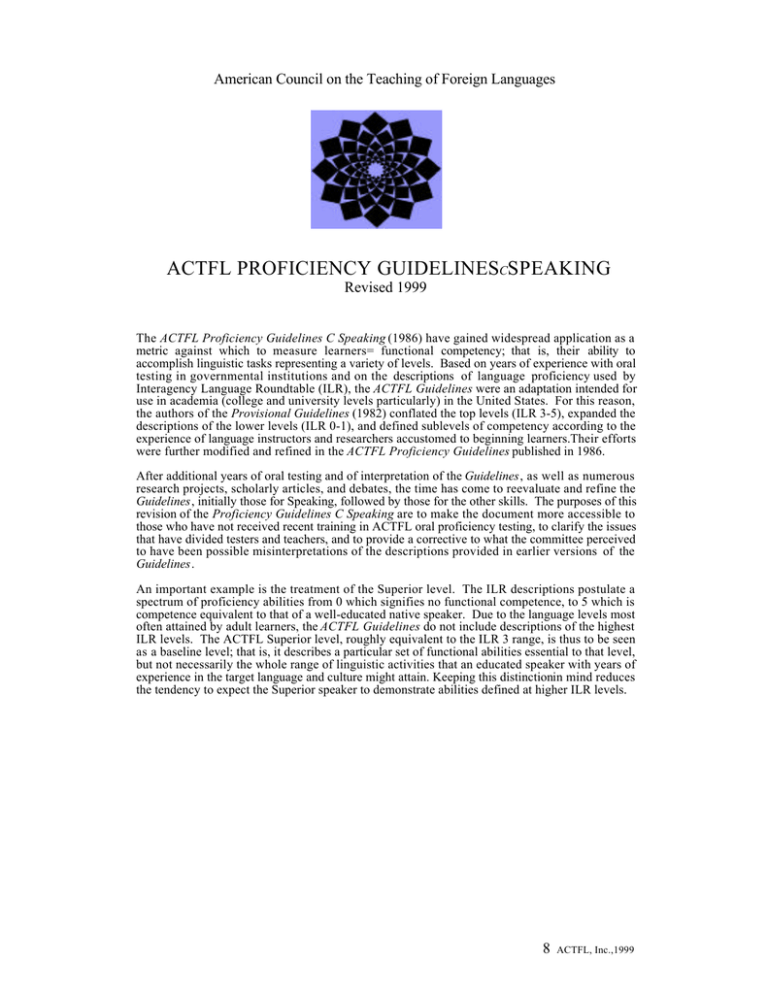
American Council on the Teaching of Foreign Languages ACTFL PROFICIENCY GUIDELINESCSPEAKING Revised 1999 The ACTFL Proficiency Guidelines C Speaking (1986) have gained widespread application as a metric against which to measure learners= functional competency; that is, their ability to accomplish linguistic tasks representing a variety of levels. Based on years of experience with oral testing in governmental institutions and on the descriptions of language proficiency used by Interagency Language Roundtable (ILR), the ACTFL Guidelines were an adaptation intended for use in academia (college and university levels particularly) in the United States. For this reason, the authors of the Provisional Guidelines (1982) conflated the top levels (ILR 3-5), expanded the descriptions of the lower levels (ILR 0-1), and defined sublevels of competency according to the experience of language instructors and researchers accustomed to beginning learners.Their efforts were further modified and refined in the ACTFL Proficiency Guidelines published in 1986. After additional years of oral testing and of interpretation of the Guidelines, as well as numerous research projects, scholarly articles, and debates, the time has come to reevaluate and refine the Guidelines, initially those for Speaking, followed by those for the other skills. The purposes of this revision of the Proficiency Guidelines C Speaking are to make the document more accessible to those who have not received recent training in ACTFL oral proficiency testing, to clarify the issues that have divided testers and teachers, and to provide a corrective to what the committee perceived to have been possible misinterpretations of the descriptions provided in earlier versions of the Guidelines. An important example is the treatment of the Superior level. The ILR descriptions postulate a spectrum of proficiency abilities from 0 which signifies no functional competence, to 5 which is competence equivalent to that of a well-educated native speaker. Due to the language levels most often attained by adult learners, the ACTFL Guidelines do not include descriptions of the highest ILR levels. The ACTFL Superior level, roughly equivalent to the ILR 3 range, is thus to be seen as a baseline level; that is, it describes a particular set of functional abilities essential to that level, but not necessarily the whole range of linguistic activities that an educated speaker with years of experience in the target language and culture might attain. Keeping this distinctionin mind reduces the tendency to expect the Superior speaker to demonstrate abilities defined at higher ILR levels. 8 ACTFL, Inc.,1999 For this reason, among others, the committee has broken with tradition by presenting this version of the Speaking Guidelines C in descending rather than ascending order. This top-down approach has two advantages. First, it emphasizes that the High levels are more closely related to the level above than to the one below, and represents a considerable step towards accomplishing the functions at the level above, not just excellence in the functions of the level itself. Second, it allows for fewer negatives and less redundancy in the descriptions when they refer, as they must, to the inability of a speaker to function consistently at a higher level. Another significant change to the 1986 version of the Guidelines is found in the division of the Advanced level into the High, Mid, and Low sublevels. This decision reflects the growing need in both the academic and commercial communities to more finely delineate a speaker=s progress through the Advanced level of proficiency. The new descriptors for Advanced Mid and Advanced Low are based on hundreds of Advanced-level language samples from OPI testing across a variety of languages. The committee has also taken a slightly different approach to the presentation of these Guidelines from previous versions. The full prose descriptions of each level (and, when applicable, its sub-levels) are preceded by clearly delineated thumb-nail sketches that are intended to alert the reader to the major features of the levels and to serve as a quick reference, but not in any way to replace the full picture presented in the descriptions themselves. Indeed, at the lower levels they refer to the Mid rather than to the baseline proficiency, since they would otherwisedescribe a very limited profile and misrepresent the general expectations for the level. This revision of the ACTFL Proficiency GuidelinesCSpeaking is presented as an additional step toward more adequately describing speaking proficiency. Whereas this effort reflects a broad spectrum of experience in characterizing speaker abilities and includes a wide range of insights as a result of on-going discussions and research within the language teaching profession, the revision committee is aware that there remain a number of issues requiring further clarification and specification. It is the hope of the committee that this revision will enhance the Guidelines= utility to the language teaching and testing community in the years to come. Acknowledgments ACTFL is indebted to the following individualswho contributed to the original ACTFL Proficiency Guidelines Project of 1986: Heidi Byrnes, James Child, Nina Patrizio, Pardee Lowe, Jr., Seiichi Makino, Irene Thompson, and A. Ronald Walton. Their work was the foundation for this revision project. We would also like to thank the following committee members and reviewers who generously gave of their time and expertise during the current revision process: Lucia Caycedo Garner, Helen Hamlyn, Judith Liskin-Gasparro, Arthur Mosher, Lizette Mujica Laughlin, Chantal Thompson, and Maureen Weissenreider. Finally, ACTFL wishes to acknowledge the work of the Guidelines= editors, and authors of the Explanatory Notes that accompany the ACTFL Proficiency GuidelinesCSpeaking (Revised 1999). They are Karen E. Breiner-Sanders, Pardee Lowe, Jr., John Miles, Elvira Swender. The Revision of the ACTFL Proficiency Guidelines was supported by a grant from the United States Department of Education International Research and Studies Program . The ACTFL Proficiency Guidelines-Speaking (Revised 1999) may be used for non-profit, educational purposes only, provided that they are reproduced in their entirety, with no alterations, and with credit to ACTFL. 8 ACTFL, Inc.,1999 SUPERIOR Speakers at the Superior level are able to communicate in the language with accuracy and fluency in order to participate fully and effectively in conversations on a variety of topics in formal and informal settings from both concrete and abstract perspectives. They discuss their interests and special fields of competence, explain complex matters in detail, and provide lengthy and coherent narrations, all with ease, fluency, and accuracy. They explain their opinions on a number of topics of importance to them , such as social and political issues, and provide structured argument to support their opinions. They are able to construct and develop hypotheses to explore alternative possibilities. When appropriate, they use extended discourse without unnaturally lengthy hesitation to make their point, even when engaged in abstract elaborations. Such discourse, while coherent, may still be influenced by the Superior speakers own language patterns, rather than those of the target language. Superior speakers command a variety of interactive and discourse strategies, such as turn-taking and separating main ideas from supporting information through the use of syntactic and lexical devices, as well as intonational features such as pitch, stress and tone. They demonstrate virtually no pattern of error in the use of basic structures. However, they may make sporadic errors, particularly in low-frequency structures and in some complex high-frequency structures more common to formal speech and writing. Such errors, if they do occur, do not distract the native interlocutor or interfere with communication. ADVANCED HIGH Speakers at the Advanced-High level perform all Advanced-level tasks with linguistic ease, confidence and competence. They are able to consistently explain in detail and narrate fully and accurately in all time frames. In addition, Advanced-High speakers handle the tasks pertaining to the Superior level but cannot sustain performance at that level across a variety of topics. They can provide a structured argument to support their opinions, and they may construct hypotheses, but patterns of error appear. They can discuss some topics abstractly, especially those relating to their particular interests and special fields of expertise, but in general, they are more comfortable discussing a variety of topics concretely. Advanced-High speakers may demonstrate a well-developed ability to compensate for an imperfect grasp of some forms or for limitations in vocabulary by the confident use of communicative strategies, such as paraphrasing, circumlocution, and illustration. They use precise vocabulary and intonation to express meaning and often show great fluency and ease of speech. However, when called on to perform the complex tasks associated with the Superior level over a variety of topics, their language will at times break down or prove inadequate, or they may avoid the task altogether, for example, by resorting to simplification through the use of description or narration in place of argument or hypothesis. ADVANCED MID Speakers at the Advanced-Mid level are able to handle with ease and confidence a large number of communicative tasks. They participate actively in most informal and some formal exchanges on a variety of concrete topics relating to work, school, home, and leisure activities, as well as to events of current, public, and personal interest or individual relevance. Advanced-Mid speakers demonstrate the ability to narrate and describe in all major time frames (past, present, and future) by providing a full account, with good control of aspect, as they adapt flexibly to the demands of the conversation. Narration and description tend to be combined and interwoven to relate relevant and supporting facts in connected, paragraph-length discourse. Advanced-Mid speakers can handle successfully and with relative ease the linguistic challenges presented by a complication or unexpected turn of events that occurs within the context of a routine situation or communicative task with which they are otherwise familiar. Communicative strategies such as circumlocution or rephrasing are often employed for this purpose. The speech of Advanced-Mid speakers performing Advanced-level tasks is marked by substantial flow. Their vocabulary is fairly extensive although primarily generic in nature, except in the case of a particular area of specialization or interest. Dominant language discourse structures tend to recede, although discourse may still reflect the oral paragraph structure of their own language rather than that of the target language. Advanced-Mid speakers contribute to conversations on a variety of familiar topics, dealt with concretely, with much accuracy, clarity and precision, and they convey their intended message without misrepresentation or confusion. They are readily understood by native speakers unaccustomed to dealing with non-natives. When called on to perform functions or handle topics associated with the Superior level, the quality and/or quantity of their speech will generally decline. Advanced-Mid speakers are often able to state an opinion or cite conditions; however, they lack the ability to consistently provide a structured argument in extended discourse. Advanced-Mid speakers may use a number of delaying strategies, resort to narration, description, explanation or anecdote, or simply attempt to avoid the linguistic demands of Superior-level tasks. 8 ACTFL, Inc.,1999 ADVANCED LOW Speakers at the Advanced-Low level are able to handle a variety of communicative tasks, although somewhat haltingly at times. They participate actively in most informal and a limited number of formal conversations on activities related to school, home, and leisure activities and, to a lesser degree, those related to events of work, current, public, and personal interest or individual relevance. Advanced-Low speakers demonstrate the ability to narrate and describe in all major time frames (past, present and future) in paragraph length discourse, but control of aspect may be lacking at times. They can handle appropriately the linguistic challenges presented by a complication or unexpected turn of events that occurs within the context of a routine situation or communicative task with which they are otherwise familiar, though at times their discourse may be minimal for the level and strained. Communicative strategies such as rephrasing and circumlocution may be employed in such instances. In their narrations and descriptions, they combine and link sentences into connected discourse of paragraph length. When pressed for a fuller account, they tend to grope and rely on minimal discourse. Their utterances are typically not longer than a single paragraph. Structure of the dominant language is still evident in the use of false cognates, literal translations, or the oral paragraph structure of the speaker's own language rather than that of the target language. While the language of Advanced-Low speakers may be marked by substantial, albeit irregular flow, it is typically somewhat strained and tentative, with noticeable self-correction and a certain >grammatical roughness.= The vocabulary of Advanced-Low speakers is primarily generic in nature. Advanced-Low speakers contribute to the conversation with sufficient accuracy, clarity, and precision to convey their intended message without misrepresentation or confusion, and it can be understood by native speakers unaccustomed to dealing with non-natives, even though this may be achieved through repetition and restatement. When attempting to perform functions or handle topics associated with the Superior level, the linguistic quality and quantity of their speech will deteriorate significantly. INTERMEDIATE HIGH Intermediate-High speakers are able to converse with ease and confidence when dealing with most routine tasks and social situations of the Intermediate level. They are able to handle successfully many uncomplicated tasks and social situations requiring an exchange of basic information related to work, school, recreation, particular interests and areas of competence, though hesitation and errors may be evident. Intermediate-High speakers handle the tasks pertaining to the Advanced level, but they are unable to sustain performance at that level over a variety of topics. With some consistency, speakers at the Intermediate High level narrate and describe in major time frames using connected discourse of paragraph length. However, their performance of these Advanced-level tasks will exhibit one or more features of breakdown, such as the failure to maintain the narration or description semantically or syntactically in the appropriate major time frame, the disintegration of connected discourse, the misuse of cohesive devises, a reduction in breadth and appropriateness of vocabulary, the failure to successfully circumlocute, or a significant amount of hesitation. Intermediate-High speakers can generally be understood by native speakers unaccustomed to dealing with non-natives, although the dominant language is still evident (e.g. use of code-switching, false cognates, literal translations, etc.), and gaps in communication may occur. INTERMEDIATE MID Speakers at the Intermediate-Mid level are able to handle successfully a variety of uncomplicated communicative tasks in straightforward social situations. Conversation is generally limited to those predictable and concrete exchanges necessary for survival in the target culture; these include personal information covering self, family, home, daily activities, interests and personal preferences, as well as physical and social needs, such as food, shopping, travel and lodging. Intermediate-Mid speakers tend to function reactively, for example, by responding to direct questions or requests for information. However, they are capable of asking a variety of questions when necessary to obtain simple information to satisfy basic needs, such as directions, prices and services. When called on to perform functions or handle topics at the Advanced level, they provide some information but have difficulty linking ideas, manipulating time and aspect, and using communicative strategies, such as circumlocution. Intermediate-Mid speakers are able to express personal meaning by creating with the language, in part by combining and recombining known elements and conversational input to make utterances of sentence length and some strings of sentences. Their speech may contain pauses, reformulations and self-corrections as they search for adequate vocabulary and appropriate language forms to express themselves. Because of inaccuracies in their vocabulary and/or pronunciation and/or grammar and/or syntax, misunderstandings can occur, but Intermediate-Mid speakers are generally understood by sympathetic interlocutors accustomed to dealing with non-natives. 8 ACTFL, Inc.,1999 INTERMEDIATE LOW Speakers at the Intermediate-Low level are able to handle successfully a limited number of uncomplicated communicative tasks by creating with the language in straightforward social situations. Conversation is restricted to some of the concrete exchanges and predictable topics necessary for survival in the target language culture. These topics relate to basic personal information covering, for example, self and family, some daily activities and personal preferences, as well as to some immediate needs, such as ordering food and making simple purchases. At the Intermediate-Low level, speakers are primarily reactive and struggle to answer direct questions or requests for information, but they are also able to ask a few appropriate questions. Intermediate-Low speakers express personal meaning by combining and recombining into short statements what they know and what they hear from their interlocutors. Their utterances are often filled with hesitancy and inaccuracies as they search for appropriate linguistic forms and vocabulary while attempting to give form to the message. Their speech is characterized by frequent pauses, ineffective reformulations and self-corrections. Their pronunciation, vocabulary and syntax are strongly influenced by their first language but, in spite of frequent misunderstandings that require repetition or rephrasing, Intermediate-Low speakers can generally be understood by sympathetic interlocutors, particularly by those accustomed to dealing with non-natives. NOVICE HIGH Speakers at the Novice-High level are able to handle a variety of tasks pertaining to the Intermediate level, but are unable to sustain performance at that level. They are able to manage successfully a number of uncomplicated communicative tasks in straightforward social situations. Conversation is restricted to a few of the predictable topics necessary for survival in the target language culture, such as basic personal information, basic objects and a limited number of activities, preferences and immediate needs. Novice-High speakers respond to simple, direct questions or requests for information; they are able to ask only a very few formulaic questions when asked to do so. Novice-High speakers are able to express personal meaning by relying heavily on learned phrases or recombinations of these and what they hear from their interlocutor. Their utterances, which consist mostly of short and sometimes incomplete sentences in the present, may be hesitant or inaccurate. On the other hand, since these utterances are frequently only expansions of learned material and stock phrases, they may sometimes appear surprisingly fluent and accurate. These speakers= first language may strongly influence their pronunciation, as well as their vocabulary and syntax when they attempt to personalize their utterances. Frequent misunderstandings may arise but, with repetition or rephrasing, Novice-High speakers can generally be understood by sympathetic interlocutors used to non-natives. When called on to handle simply a variety of topics and perform functions pertaining to the Intermediate level, a NoviceHigh speaker can sometimes respond in intelligible sentences, but will not be able to sustain sentence level discourse. NOVICE MID Speakers at the Novice-Mid level communicate minimally and with difficulty by using a number of isolated words and memorized phrases limited by the particular context in which the language has been learned. When responding to direct questions, they may utter only two or three words at a time or an occasional stock answer. They pause frequently as they search for simple vocabulary or attempt to recycle their own and their interlocutor=s words. Because of hesitations, lack of vocabulary, inaccuracy, or failure to respond appropriately, Novice-Mid speakers may be understood with great difficulty even by sympathetic interlocutors accustomed to dealing with non-natives. When called on to handle topics by performing functions associated with the Intermediate level, they frequently resort to repetition, words from their native language, or silence. NOVICE LOW Speakers at the Novice-Low level have no real functional ability and, because of their pronunciation, they may be unintelligible. Given adequate time and familiar cues, they may be able to exchange greetings, give their identity, and name a number of familiar objects from their immediate environment. They are unable to perform functions or handle topics pertaining to the Intermediate level, and cannot therefore participate in a true conversational exchange. 8 ACTFL, Inc.,1999
